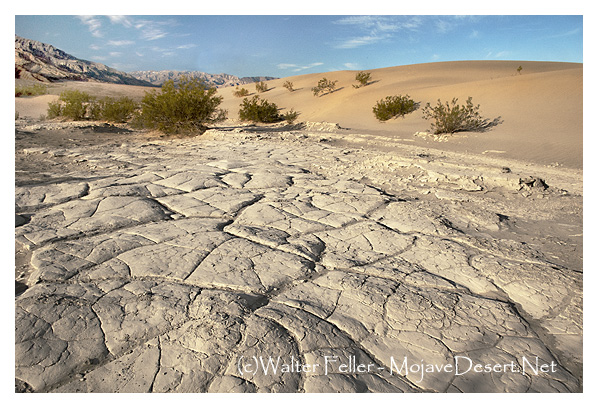TOP -- A B C D E F G H I J K L M N O P Q R S T U V W X Y Z
Blowout Dunes
A general term for various saucer, cup, or trough-shaped hollows formed by erosion on a pre-existing dune or other sand deposit. Vegetation is often found on blowouts.
Dune blowout in Mesquite Flats Sand Dunes, Death Valley National Park
In the Mojave Desert, blowout dunes are not as common or dramatic as in coastal dune fields, but they do occur in certain places where wind, sand supply, and sparse vegetation all come together. Here is how they fit into the Mojave context:
Formation in the Mojave
Most Mojave dunes form from sand carried out of dry lakebeds (playas) or river channels such as the Mojave River. When vegetation—creosote, saltbush, mesquite, or other desert shrubs—gets thinned out by grazing, off-road vehicles, drought, or simply patchy distribution, the wind exploits those weak spots. The wind scours a shallow bowl or trough in the sand deposit, creating a blowout. Over time, the hollow may expand into a broad depression with steep rims and sand tongues drifting downwind.Typical Locations
Around Kelso Dunes: Small blowouts appear where hikers and wind action have stripped plants off the outer margins.Silurian Valley and Dumont Dunes: Patches of vegetation anchoring dune fields show classic blowout hollows.
Smaller examples can be seen on the edges of playas such as Soda Dry Lake or Cronese Lakes, where winds from the Mojave River basin funnel through gaps and scoop out sand.
Appearance
Mojave blowouts usually look like small craters or scooped-out bowls in the dune surface, often opening toward the prevailing wind direction.They can be only a few feet across or expand to tens of yards, depending on how persistent the wind is and how much vegetation is lost.
The rims are sometimes lined with tougher plants clinging on, while the hollow itself stays bare and shifting.
Ecological Role
Though destructive to stabilizing plants, blowouts create microhabitats. Certain insects and reptiles take advantage of the loose, open sand. Over decades, desert shrubs may slowly recolonize, healing the blowout unless human disturbance keeps it active. So in the Mojave, blowout dunes are like scars on a living dune system—signs of wind power, disturbance, and the delicate balance between sand movement and vegetation.List of dune fields where blowout dunes can be seen, including Death Valley:
Kelso Dunes (Mojave National Preserve)
One of the largest dune fields in the Mojave.Blowouts appear along the outer edges where creosote and other plants have been stripped away.
Visitor traffic has also helped trigger small blowouts near the main access trails.
Dumont Dunes (north of Baker)
Fed by sand from the Amargosa River.Blowouts form in vegetated patches where mesquite or saltbush once held the sand.
Off-road vehicle use has expanded many of these hollows.
Silurian Valley Dunes
Smaller dune fields along the valley floor, less visited than Dumont.Blowouts are common in spots where thin vegetation has been disturbed, leaving bowl-shaped depressions that funnel sand downwind.
Cronese and Soda Lake Margins (near Baker)
Wind working off the dry lakebeds creates scattered dune mounds.Blowouts occur when shrubs die off, leaving small U-shaped craters in the dune faces.
Ibex Dunes (south Death Valley)
Isolated dune field, more fragile than Kelso or Dumont.Blowouts here are visible where sparse vegetation is eroded away by steady winds, creating small depressions along the dune rims.
Eureka Dunes (northern Death Valley)
Among the tallest dunes in California.Blowouts are less common due to limited vegetation, but hollows still form where winds scour through thinly vegetated slopes.
Mesquite Flat Dunes (central Death Valley near Stovepipe Wells)
Highly visited dune field.Blowouts appear along the margins where creosote bushes once anchored sand.
Foot traffic and natural wind scouring keep many blowouts active.